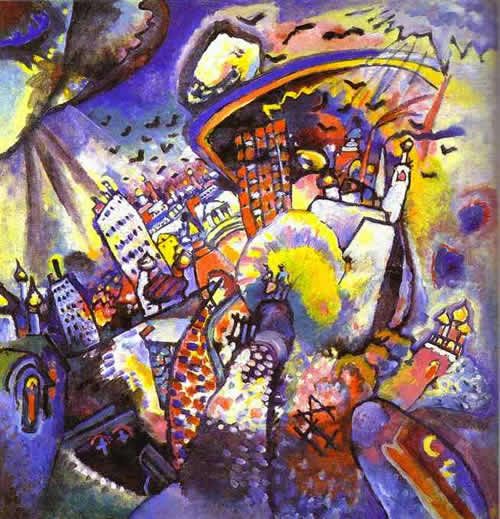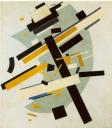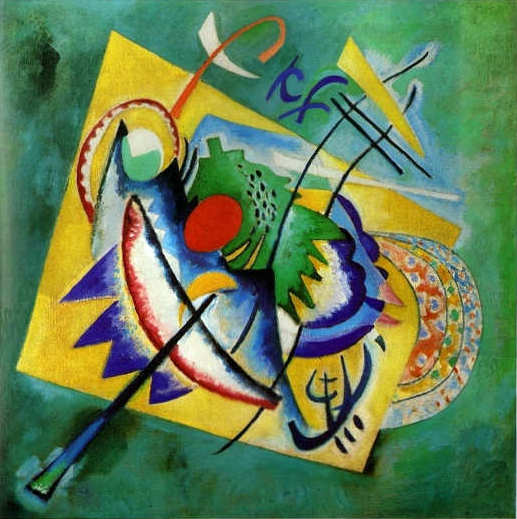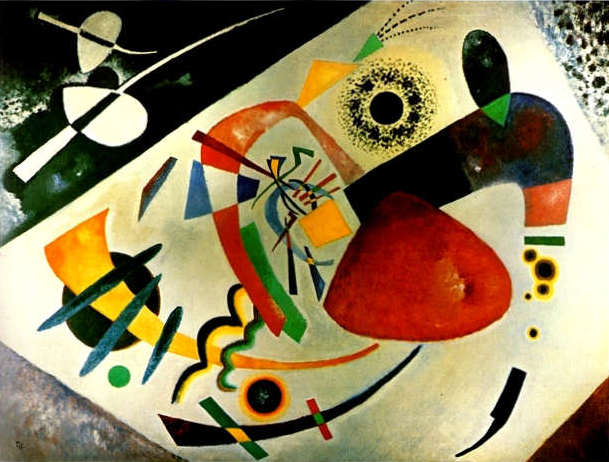After the outbreak of World War II, Kandinsky’s Russian passport branded him an enemy alien in Murnau and he was forced to travel first to Switzerland, and then to Russia. With that move came a break-up with Gabrielle Munter, his longtime mistress. In 1915, Kandinsky did not paint one painting. Then, in the autumn of 1916, he met Nina Andreevsky, who would become his second wife. In 1916 he wrote Gabrielle Munter, “I felt that my old dream was closer to coming true. You know that I dreamt of painting a big picture expressing joy, the happiness of life and the universe. Suddenly I feel the harmonies of colors and forms that come from this world of joy.”
In this mood, Kandinsky painted Moscow I (Red Square) (1916), seen below. Here, the romantic, fairytale-like Moscow pictures of Kandinsky’s early years are combined with church motifs and the splintered forms and dynamism found in his pre-war paintings. the effect is to create a dramatic, explosive vision of harmony of colors and forms. The couple in the middle of the picture introduce a romanticizing element into a composition otherwise dominated by the primary colors of red, blue, and yellow.

In 1914, the Russian translation of On the Spiritual in Art was published. Kandinsky’s ideas of a complete elimination of the associative and representational influenced his Russian contemporaries to take it a step further: instead of following Kandinsky’s abstract-expressive non-representationalism, they embraced a purely geometric abstraction. Kasimir Malevich was one participant in the new movement, called Suprematism, referring to the supremacy of pure feeling. His work, Supremus No. 58 (1918), presents clear geometric forms on a white canvas. The trapezoid was the emblem of Suprematism.

Kandinsky utilized the trapezoid motif in Red Oval (1920), placing the yellow plane against a green background, where the plane appears to float in an undefined, atmospheric space. This differed greatly from Constructivist habits (preferred by the Suprematists) of disciplined and 2-dimensional compositional structure. Kandinsky gave first priority to composition rather than construction, and to intuition rather than reason. Red Oval also differs from Suprematist work in that Kandinsky pins his quadrilateral to the background, instead of intensifying the outward movement of the yellow plane.

The last pictures Kandinsky painted in Moscow also combined free and geometrizing elements. In Red Spot II (1921), points of intersection have become points of penetration instead of points of intersection and underline the flatness of the pictorial plane. The trapezoid acquires a direct, immediate presence with its cut off corners, and becomes the ground for a group of symbols. Red Spot also introduces the use of circles as constructive elements, reinforcing the overall impression of calm and cool tension. The motifs of circles, points, and spots would play an increasing role in Kandinsky’s works from this point on, incrementally assuming the importance the rider had once held. (Becks-Malorny p. 124)

Kandinsky praised the point as a device capable of “altering its outer shape, whereby it can change from the purely mathematical form of a larger or smaller circle to forms of unlimited versatility and variability, far removed from any schematism.” In his disagreements with his Constructivist colleagues, Kandinsky was brought into Soviet politics. In 1921, the new economic policy was announced by the Communist Party, and abstract art was branded damaging and subversive. Kandinsky, a self-described “non-political” citizen, came closer to leaving Russia.